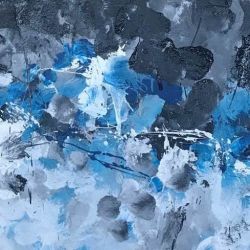Skip to main content
Wescover has transitioned to an inquiry only platform.
Please refer to our FAQs for more details.
Please refer to our FAQs for more details.
John Warren Travis
San Francisco, CA
"Before devoting himself full-time to painting, Warren Travis enjoyed a long career as a theatre designer. As an artist, he has, therefore, significantly shifted his focus—from an art form that is, by nature, collaborative to one that is almost always singular, from art that is part of a time-bound, performative whole, to one in which the created object stands alone. The contrast is not, of course, black and white; there are, inevitably, traces of his former life in his current work, notably in a differently expressed but still central collaborative impulse. No longer beholden to dramatists, directors, actors, lighting designers, and the rest, there remains the audience, for which he feels considerable responsibility, and, most fascinating, the question of inspiration.
Broadly educated and widely read, Travis has long been drawn to visual art that describes, incorporates or relates closely to works in other media ("ekphrastic", to use the time-honored term): “Howard Hodgkins inspired by A.E. Houseman; Cy Twombley awash in words from great Greek poems crudely scrawled like graffiti; Joan Mitchell’s Hemlock, one of my favorite paintings, inspired by Wallace Stevens’s Definition in Black.” Travis greatly admires Mitchell, and it was Hemlock that first led him to Stevens. The recent Blackbird series is, in fact, an oblique homage to Thirteen Ways of Looking at a Blackbird (1917)—the relationship of drawings to poem implied rather than explicit, the drawings a parallel expression, related but not dependent. The viewer is free to explore the subtleties of the layered relationship or not; in either case, the drawings stand on their own. For Travis, the challenge is to balance inspiration/influences with uniquely personal expression, a feat at which he feels Joan Mitchell excelled.
13 Ways of Looking at a Blackbird—burnished graphite on parchment, each eighteen inches square—are simultaneously intimate and powerful, even aggressive—one drawing one in, the next bursting from the sheet. Created as a series in which each is autonomous, they are richly varied. The birds strut, perch, flutter, descend; one emerges from a densely gestural, weighted matrix; another appears ephemeral, barely there. A near-abstract, architectonic arc, all noisy flutter, is followed by one so utterly quiet and serene as to encourage a whispered response. What appear at first glance to be sparingly applied white highlights, turn out to be aggressive erasure, a stylistic mirroring of the images’ emotional extremes.
Deeply thoughtful, Warren Travis both relishes and is daunted by the painting process, and philosophical about its challenges. He often works in series, investigating subjects over time, from shifting perspectives, interested in observing changes in what (and how) he sees. “The joy of painting is immense,“ he says. “The successes and failures (which seem to be necessarily intertwined), rather than making one overconfident or despairing bring one into reality. My greatest pleasure is seeing myself and understanding. It is humbling.”"
Broadly educated and widely read, Travis has long been drawn to visual art that describes, incorporates or relates closely to works in other media ("ekphrastic", to use the time-honored term): “Howard Hodgkins inspired by A.E. Houseman; Cy Twombley awash in words from great Greek poems crudely scrawled like graffiti; Joan Mitchell’s Hemlock, one of my favorite paintings, inspired by Wallace Stevens’s Definition in Black.” Travis greatly admires Mitchell, and it was Hemlock that first led him to Stevens. The recent Blackbird series is, in fact, an oblique homage to Thirteen Ways of Looking at a Blackbird (1917)—the relationship of drawings to poem implied rather than explicit, the drawings a parallel expression, related but not dependent. The viewer is free to explore the subtleties of the layered relationship or not; in either case, the drawings stand on their own. For Travis, the challenge is to balance inspiration/influences with uniquely personal expression, a feat at which he feels Joan Mitchell excelled.
13 Ways of Looking at a Blackbird—burnished graphite on parchment, each eighteen inches square—are simultaneously intimate and powerful, even aggressive—one drawing one in, the next bursting from the sheet. Created as a series in which each is autonomous, they are richly varied. The birds strut, perch, flutter, descend; one emerges from a densely gestural, weighted matrix; another appears ephemeral, barely there. A near-abstract, architectonic arc, all noisy flutter, is followed by one so utterly quiet and serene as to encourage a whispered response. What appear at first glance to be sparingly applied white highlights, turn out to be aggressive erasure, a stylistic mirroring of the images’ emotional extremes.
Deeply thoughtful, Warren Travis both relishes and is daunted by the painting process, and philosophical about its challenges. He often works in series, investigating subjects over time, from shifting perspectives, interested in observing changes in what (and how) he sees. “The joy of painting is immense,“ he says. “The successes and failures (which seem to be necessarily intertwined), rather than making one overconfident or despairing bring one into reality. My greatest pleasure is seeing myself and understanding. It is humbling.”"
Wescover creator since 2017
Filter Items
Category
All
Paintings
Art
Projects Portfolio
Zuni Café
San Francisco, CA
